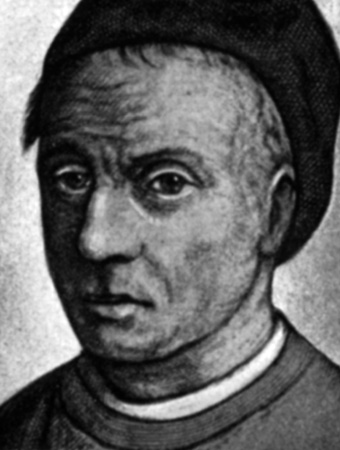( – promoted by undercovercalico)

Previous episodes:
Desiderius Erasmus Roterodamus received his baccalaureate degree in theology in 1497 at the Collège de Montaigu in Paris, where he studied under the mentorship of Jan Standonck, after being mentored at Deventer by the German humanist Alexander Hegius. It seems we have strayed far from mathematics, but we shall return. This was the time of “men for all seasons.”
Jan Standonck was a reformer. What better way was there in 15th century France to reform the Church than to reform its educational system. A follower of the ascetic Saint Francis the Fire Handler, he found his vocation to be the establishment of colleges dedicated to educating the poor.
He himself was educated at the monastic school in Gouda run by the Brethren of the Common Life. He enrolled for a time at Leuven, but not much is known about that period. We do know he eventually showed up in Paris, performing menial labor in return for an education from the monks of Sainte Genevieve. Upon receiving his degree he became Regent at Montaigu, where he worked his way up to Master of the college and the librarian at the Sorbonne.
When he became Rector of the college, his students mutinied because of his reputation for strictness. He had to call the cops to complain about students not attending his lectures.
Erasmus…later said he did not think anyone could forget – or even survive unscathed – their time at the College.
 Alexander Hegius von Heek was master of the school at Deventer where Erasmus studied before being sent to study under Standonck. There he wrote poems, philosophical essays, letters and notes on grammar, published posthumously by one of his other students, Jacobus Faber, aka Jacques Lefèvre d’Étaple.
Alexander Hegius von Heek was master of the school at Deventer where Erasmus studied before being sent to study under Standonck. There he wrote poems, philosophical essays, letters and notes on grammar, published posthumously by one of his other students, Jacobus Faber, aka Jacques Lefèvre d’Étaple.
Hegius is chiefly remembered for reforming the medieval methods of education, preferring to have his students read the actual work of the classical authors. And he is, of course, known for his students, which in addition to Erasmus and Lefèvre, included Pope Adrian VI, the last non-Italian pope before John Paul II.
Hegius was educated at the Latin school in Zwolle, at the convent of St. Agnes, where he was a pupil of Thomas à Kempis, graduating in the early 1470s.
 Thomas Hemerken (little hammer) was born in Kempen in 1380 and apparently buried alive in 1471, since splinters were later found under the fingernails of his corpse. Trying to get out of the coffin apparently has cost him a sainthood.
Thomas Hemerken (little hammer) was born in Kempen in 1380 and apparently buried alive in 1471, since splinters were later found under the fingernails of his corpse. Trying to get out of the coffin apparently has cost him a sainthood.
He was educated at the school in Deventer run by the Brethren of the Common Life and learned to support himself as a copyist. After entering the convent of Mount Saint Agnes in Zwolle, where his brother had proceeded him as the prior, he copied the Bible four times. Thomas was ordained in 1413.
His writings were devotional, for the most part, tracts, meditations, letters, sermons, a biography of Saint Lidwina (interesting footnote: perhaps the first multiple sclerosis patient ever), and biographies of his teachers and their companions.
 And there were some more long lasting creations. He wrote The Imitation of Christ in 1418. Those not familiar with the work will still recognize some of its words:
And there were some more long lasting creations. He wrote The Imitation of Christ in 1418. Those not familiar with the work will still recognize some of its words:
At the Day of Judgement we shall not be asked what we have read but what we have done.
For man proposeth, but God disposeth
If, however, you seek Jesus in all things, you will surely find Him.
If that seems to biblical for you, he also wrote these words, which my taoist ear finds somewhat pleasing:
Without the Way, there is no going, Without the Truth, there is no knowing, Without the Life, there is no living.
If thou wilt receive profit, read with humility, simplicity and faith, and seek not at any time the fame of being learned.
We have almost arrived at the end of the trail. Thomas was a follower of Geert Groote and Florentius Radewijns, the founders of the the Brethren of the Common Life. The last leg of our journey leads through them.
To be continued

4 comments
Skip to comment form
Author
…sent the following interesting note after last week’s episode:
(Pardoning me for editing the communication a bit).
Many thanks, Jan!
Robyn
PS: The painting at the top of this side of the fold is Thomas à Kempis on Mount Agnes (1569), artist unknown. Neither can I discern the artist of the portrait.
Author
Maybe there’s an anti-greed lesson in amongst the historical ramblings.
🙂